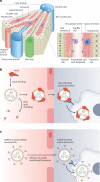Passive, active and endogenous organ-targeted lipid and polymer nanoparticles for delivery of genetic drugs
- PMID: 36691401
- PMCID: PMC9850348
- DOI: 10.1038/s41578-022-00529-7
Passive, active and endogenous organ-targeted lipid and polymer nanoparticles for delivery of genetic drugs
Abstract
Genetic drugs based on nucleic acid biomolecules are a rapidly emerging class of medicines that directly reprogramme the central dogma of biology to prevent and treat disease. However, multiple biological barriers normally impede the intracellular delivery of nucleic acids, necessitating the use of a delivery system. Lipid and polymer nanoparticles represent leading approaches for the clinical translation of genetic drugs. These systems circumnavigate biological barriers and facilitate the intracellular delivery of nucleic acids in the correct cells of the target organ using passive, active and endogenous targeting mechanisms. In this Review, we highlight the constituent materials of these advanced nanoparticles, their nucleic acid cargoes and how they journey through the body. We discuss targeting principles for liver delivery, as it is the organ most successfully targeted by intravenously administered nanoparticles to date, followed by the expansion of these concepts to extrahepatic (non-liver) delivery. Ultimately, this Review connects emerging materials and biological insights playing key roles in targeting specific organs and cells in vivo.
Keywords: Biomedical engineering; Drug delivery.
© Springer Nature Limited 2023, Springer Nature or its licensor (e.g. a society or other partner) holds exclusive rights to this article under a publishing agreement with the author(s) or other rightsholder(s); author self-archiving of the accepted manuscript version of this article is solely governed by the terms of such publishing agreement and applicable law.
Conflict of interest statement
Competing interestsD.J.S.: ReCode Therapeutics, co-founder, consultant and Scientific Advisory Board; Tome Biosciences, Scientific Advisory Board. D.J.S., S.A.D. and the Regents of the University of Texas System have filed patent applications related to delivery technologies.
Figures



Similar articles
-
Nanoparticles for vaccine and gene therapy: Overcoming the barriers to nucleic acid delivery.Wiley Interdiscip Rev Nanomed Nanobiotechnol. 2022 Nov;14(6):e1809. doi: 10.1002/wnan.1809. Wiley Interdiscip Rev Nanomed Nanobiotechnol. 2022. PMID: 36416028 Free PMC article. Review.
-
Extrahepatic targeting of lipid nanoparticles in vivo with intracellular targeting for future nanomedicines.Adv Drug Deliv Rev. 2022 Sep;188:114417. doi: 10.1016/j.addr.2022.114417. Epub 2022 Jul 3. Adv Drug Deliv Rev. 2022. PMID: 35787389 Review.
-
Advanced targeted therapies in cancer: Drug nanocarriers, the future of chemotherapy.Eur J Pharm Biopharm. 2015 Jun;93:52-79. doi: 10.1016/j.ejpb.2015.03.018. Epub 2015 Mar 23. Eur J Pharm Biopharm. 2015. PMID: 25813885 Review.
-
Biocompatible Polymer Nanoparticles for Drug Delivery Applications in Cancer and Neurodegenerative Disorder Therapies.J Funct Biomater. 2019 Jan 8;10(1):4. doi: 10.3390/jfb10010004. J Funct Biomater. 2019. PMID: 30626094 Free PMC article. Review.
-
Selective organ targeting nanoparticles: from design to clinical translation.Nanoscale Horiz. 2023 Aug 21;8(9):1155-1173. doi: 10.1039/d3nh00145h. Nanoscale Horiz. 2023. PMID: 37427677 Review.
Cited by
-
Peptide-coated DNA nanostructures as a platform for control of lysosomal function in cells.Chem Eng J. 2024 Oct 15;498:155633. doi: 10.1016/j.cej.2024.155633. Epub 2024 Sep 12. Chem Eng J. 2024. PMID: 39372137
-
Current landscape of mRNA technologies and delivery systems for new modality therapeutics.J Biomed Sci. 2024 Sep 10;31(1):89. doi: 10.1186/s12929-024-01080-z. J Biomed Sci. 2024. PMID: 39256822 Free PMC article. Review.
-
The interplay of quaternary ammonium lipid structure and protein corona on lung-specific mRNA delivery by selective organ targeting (SORT) nanoparticles.J Control Release. 2023 Sep;361:361-372. doi: 10.1016/j.jconrel.2023.07.058. Epub 2023 Aug 10. J Control Release. 2023. PMID: 37536547 Free PMC article.
-
Ionic liquid-coated lipid nanoparticles increase siRNA uptake into CNS targets.Nanoscale Adv. 2023 Dec 5;6(7):1853-1873. doi: 10.1039/d3na00699a. eCollection 2024 Mar 26. Nanoscale Adv. 2023. PMID: 38545295 Free PMC article.
-
Recent advances in nanomedicine design strategies for targeting subcellular structures.iScience. 2024 Dec 12;28(1):111597. doi: 10.1016/j.isci.2024.111597. eCollection 2025 Jan 17. iScience. 2024. PMID: 39811659 Free PMC article. Review.
References
Publication types
LinkOut - more resources
Full Text Sources
Other Literature Sources
